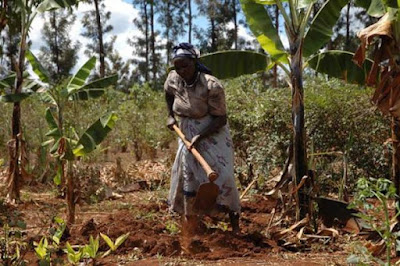By Bob Aston
In addition, the Maarifa
Centre also collaborated with the Ministry of Agriculture, Livestock and
Fisheries, MEA Ltd and Laikipia Produce and Marketing Cooperative Society in
establishing five conservation agriculture demonstration plots.
Established in 2007 by
the Arid Lands Information Network (ALIN), Ng’arua Marifa Centre in Ol-Moran
Ward at Laikipia West Sub County has been facilitating learning and skills
transfer among communities embracing a culture of knowledge sharing.
The Maarifa Centre has
been offering free services that include Library services, E-government
services, multimedia content, internet access, citizen journalism training, ICT training, advisory services, publications like Baobab, Joto Afrika, and Laikipia Mali Asili, SOKO+ and Farm Records Management Information System (FARMIS-Kenya).
The Maarifa Centre has
also hosted a Natural Resource Management (NRM) and Sustainable Land Management
(SLM) knowledge sharing Mazingira Centre.
| Beneficiaries of one of ALIN`s initiatives |
This year more than 2,000
community members have benefited through various services at the Maarifa
Centre. In addition, 721 farmers benefited through field days and workshops.
The Centre has been
instrumental in sharing knowledge with farmers through organizing open learning
days, exchange visits, outreach events, video documentations, and articles
aimed at farmers and pastoralists.
The year at a glance
During the year, ALIN
through the Maarifa Centre successfully completed the implementation of the
United Nations Development Program (UNDP) Global Environment Facility (GEF)
Small Grants Program (SGP) project titled: “Enhancing Communities’
Participation for effective Natural Resources management and Enhanced
Resilience in Laikipia County.”
The project offered a
platform for knowledge sharing between partners supported by UNDP under GEF
SGP. The project saw the inception of Laikipia Mali Asili newsletter while 30
grantees and other partners received citizen journalism training.
The year also saw the
successful completion of Climate Smart Agriculture project in Matwiku area. The
project aimed to strengthen communities’ resilience to impacts of climate
change while conserving natural resources in Laikipia County.
Members of Matwiku
Horticulture Growers Self Help Group were capacity built on drip irrigation
installation, water harvesting technologies, plant protection, harvesting,
value addition, marketing and climate smart Agriculture.
ALIN through the Maarifa
Centre also increased capacity-building support for Laikipia Produce and
Marketing Cooperative Society during the year. The cooperative emerged from the
work undertaken by ALIN with the support of the Ford Foundation’s Expanding
Livelihoods for Poor Households Initiative (ELOPHI).
Three years down the
line, the cooperative is among the fastest growing in Laikipia West Sub County
and farmers have started benefiting through various services from the
cooperative.
Strengthening maize, tree
tomato, and tomato value chains has been a key achievement during the year. Through
a participatory approach in 2013, farmers had identified the three value chains
as the priority areas in the ward.
ALIN through the Maarifa
Centre has held workshops and field days for farmers involved in the three
value chains. Such forums have enabled them to enhance their production skills,
share production, and marketing experiences, enhance systematic record keeping,
and create linkages. Investing in the three value chains is an ideal way of
promoting inclusive economic growth.
 |
| ALIN christmas card |
Social media platforms reach
The Laikipia Rural Voices (LRV) and Ng’arua Maarifa Centre blogs have reached a wider audience this year. The blogs
have been highlighting community local issues, development initiatives, farmer
innovations, climate change adaptation, climate smart agriculture, natural
resource management, successes, and issues faced by youths in agriculture,
environmental conservation, and other livelihood issues.
Blog articles shared
through LRV this year are 203 while articles shared through Ng’arua Marifa
centre blog stands at 106 this year. Blog visitors now stand at 119,104 and
82,464 for LRV and Ng’arua Maarifa Centre blog respectively.
Some messages received
through the various social media channels have really been uplifting. Such
responses show that many people appreciate what the Maarifa has been doing.
“I am impressed by the
work you are doing to help improve the livelihood of my people in Laikipia
West. I am always enlightened as a resident and as a professional based so many
miles away from home,” said Steve Kamario.
Special thanks go to all
the partners, blog readers as well as community members who have been
contributing articles and helped make 2015 an intense year.
These being the last blog
post in 2015, ALIN through Ng’arua Maarifa Centre would like to wish all their
readers a Merry Christmas and a Happy New Year. May this year’s Christmas end
the present year on a cheerful note and make way for a fresh and bright new
year.





